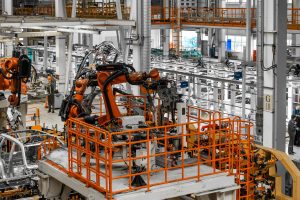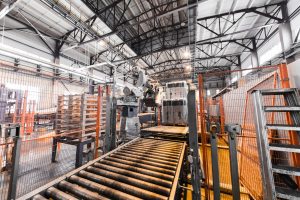In today’s fast-paced world, industrial automation is the key to unlocking new levels of efficiency, safety and profitability for businesses.
The application of automation in industries has become an important practice in organizations as it provides a new approach to enhance results in terms of speed, cost and productivity.
Thus, many enterprises leverage solutions like AI, robotics, and IoT to maintain competitiveness and survive in the modern world. So, Let’s check out the top applications of industrial automation.
5 Applications of Industrial Automation
Following are 5 major applications of industrial automation that can transform your business to a great extent.
Checkout: The Bright Future of Automation: A Look into Future of Manufacturing
1. Palletizing
Palletizing is the process where products are placed onto pallets in a way that they will be transported and stocked. This task proves to be essential in ensuring that warehouses and manufacturing businesses run their operations smoothly.
Why automate it?
Putting the bottles on pallets in an automatic and organized manner reduce time and complexity of lifting and also reduce injuries in the long run. Machines on the other hand have the ability to stack products faster and are accurate most of the time unlike humans who will need to rest.
Cost and Benefits:
- Cost: It ranges from $50 000 for simple installations to over $200 000 for sophisticated systems.
- Benefits: It means that there will be higher production rates, reduced product damages, lower risks involved in workplaces, and the ability of companies to expand their production capacities in response to higher amounts of demand.
Do you know? Therefore, warehouse robotic palletizing has the potential to significantly increase capabilities to handle greater throughput of goods as well as increase throughput by up to 30%.

2. Pick and Place
Pick and place refers to the process where objects are being selected meticulously and then transported to another area. This is particularly applicable in mechanized applications such as the electronics industry and the food packing industry among others.
Why automate it?
Automated pick and place systems are far superior to pick and place operations by human beings as they bring down the rate of mistake and allow the human resources to handle more delicate jobs.
Cost and Benefits:
- Cost: Some of the basic computer network systems requires $10,000 while the complex systems may cost over $100,000.
- Benefits: To be more specific, the benefits of implementing robots include faster productivity, greater precision, ability to perform a range of work, and considerably less hazardous working conditions.
Insight: This means that robots for pick and place can offer enhanced productivity understand up to 20% depending on the business line through which the firm is seeking robots to enhance its production capacity.
3. Assembly
Assembly can be described as a process where components are joined together to form a particular product. Applications of industrial automation in assembly enhances the likelihood of the production of identical products as well as their rate of production.
Why automate it?
One advantage of the automated assembly line is that it can sustain continuous operations during its shift without needing to have a rest hence it can produce high amount of products and at the same time the quality will be consistent in a single shift.
Cost and Benefits:
- Cost: Ranges from $25,000 for basic systems to over $200,000 for advanced technology.
- Benefits: Increased rates of production, the quality of the products produced are enhanced, easy to change the tooling for other products, and it also has the added advantage of less human effort.
Fact: Most assembly processes can be highly automated and application of automation decrease production time up to half, which improves performance in general.
Checkout: Key Difference Between Industrial Automation and Robotics
4. Quality Inspection
Quality check on the products is important in making sure that the overall standard of the qualified products will pass on to the customers.
Automated inspection is similar to visual inspection but it is more mechanical in nature as it has the assistance of technologically equipped cameras or sensors to scan for defects.
Why automate it?
Machines can work more quickly and effectively than people so all products receive quality check and will not have defective issues reaching customers.
Cost and Benefits:
- Cost: Prices range from $5,000 for simple kits up to $50,000 or more for sophisticated systems.
- Benefits: Out of the conventional inspection methods, laser scanning provides several advantages such as higher accuracy in defect detection, much faster inspection, and continuous operation, and long-term cost benefits.
Insight: There are well-documented benefits of automated quality inspection, which include cutting down the defect levels by about 40 % thereby leading to enhanced customer satisfaction level and reduced levels of customer returns.

5. Packaging
Based on the offices understanding on the definition of packaging it refers to the enclosing and conditioning of commodities for transport. Automated packaging is the process of packing products quickly and in the right manner without necessarily having to involve human participation.
Why automate it?
By industrial automation applications a packager is able to address the volume of products packed within a short period of time, and all packs meet the desirable specifications.
Cost and Benefits:
- Cost: For basic machines, the cost starts at $10,000 while advanced and complex systems can go for over $100,000.
- Benefits: Fast packaging, increased velocity, precise repeatability, and minimum material usage, the line runs 24/7/365.
Fact: By applying automation to your packaging, you will benefit greatly in terms of contributors, and possibly cut your packaging costs by a quarter.
Conclusion
Application of automation in industries has its own importance and advantages like, it increases work efficiency, accuracy and saves time and cost and also reduces the risk of injuries.
Tasks such as palletizing, pick and place, assembly, quality inspection, and packaging can be time-consuming or expensive if performed manually; However, with the application of automation in these steps, businesses rise up and become ready for today’s market.
Industrial automation is not just a trend; it’s a necessity for businesses aiming to thrive in the modern marketplace. These 5 applications of industrial automation demonstrate the vast potential of automation to transform your operations and position your business for future success.
Consider how these Industrial automation applications might fit into your business strategy. The initial investment may seem significant, but the long-term benefits of increased productivity, continuity, and security make it a worthwhile venture.
